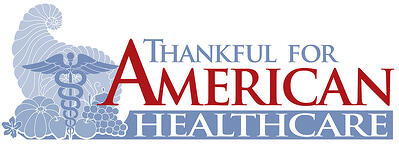
Once again, we find ourselves approaching Thanksgiving, the time of year when we reflect on all our blessings. We do, indeed have much for which to be thankful. Here are just a few ideas. Please feel free to post other “thankfuls” in the comments below!
Dedicated, highly skilled healthcare workers.
Last year, we started our list with gratitude to the doctors, nurses, technicians, pharmacists, engineers, housekeepers, administrators, and all the other workers in healthcare who spend their lives taking care of others. Their caring and hard work make a difference to us all.
Increased use of electronic health records continues to improve providers’ ability to deliver timely and accurate treatment.
Although the rapid shift from paper to electronic record keeping has been stressful for some providers, a national study published in the February 2014 issue of Health Services Research found that a whopping 78% of providers reported that using electronic records enhances the care they provide, especially in the areas of alerting them to critical lab results and warning of possible adverse medication interactions.
www.forbes.com/sites/scottatlas/2013/11/28/on-thanksgiving-lets-be-thankful-for-what-remains-of-americas-healthcare/
In addition, the same study found that the longer a provider had used electronic records, the more like she was to find it beneficial, suggesting that as more providers become accustomed to the new systems, the number reporting positive effects will increase. From the patient’s perspective, this means increased safety and reliability in their healthcare experience.
The U.S. has the greatest number per capita of advanced medical technology.
For example, according to the Organization for Economic Co-operation and Development (OECD), the U.S. has more CAT scanners and MRIs per capita than any other country. In practical terms, because they are so common, these powerful diagnostic tools are available to a greater part of the population and with shorter waiting times than anywhere in the world.
Patient empowerment is improving.
As transparency measures continue to advance in hospitals and, increasingly, in other healthcare settings, patients have more access to information that allows them to make educated decisions when choosing healthcare providers and hospitals. Furthermore, when things do go wrong, patients have a greater ability to find out exactly what happened and to help their providers find ways to prevent future occurrences of similar events.
America leads the way in healthcare innovation.
Americans have early access to cutting edge treatments and newly developed information. According to statistics reported by the Cato Institute, the U.S. consistently out-performs the E.U., Australia, and Japan in developing healthcare innovations as measured by Nobel Awards in Medicine per capita and as measured by country of origin of major medical technologies.
More and more hospitals are developing a Culture of Safety and striving to be High Reliability Organizations.
Despite the difficulties inherent in creating and implementing a new kind of hospital culture, the number of organizations embracing safety culture values, continuous improvement processes, and high reliability practices continues to increase. As a result, patient safety and positive outcomes also improve in these organizations.
No doubt, the American healthcare system faces challenges, but as the examples above illustrate, we have much for which to be thankful!
Sources
(1) King J, Patel V, Jamoom EW, Furukawa, MF. Clinical benefits of electronic health record use: national findings. Health Services Research [Internet]. 2014 Feb.[49(1.2). DOI: 10.1111/1475-6773.12135
(2) Health care resources: medical technology [Internet]. Organization for Economic Co-operation and Development. 2014 Nov 14. [cited 2014 Nov 18]. Available from: http://stats.oecd.org/Index.aspx?DataSetCode=HEALTH (link no longer available)
(3) Whitman G, Raad R (Cato Institute policy analysis no.654). Bending the productivity curve: why America leads the world in medical innovation. Washington, DC. 2009 Nov 18.:4. Ibid, 5.